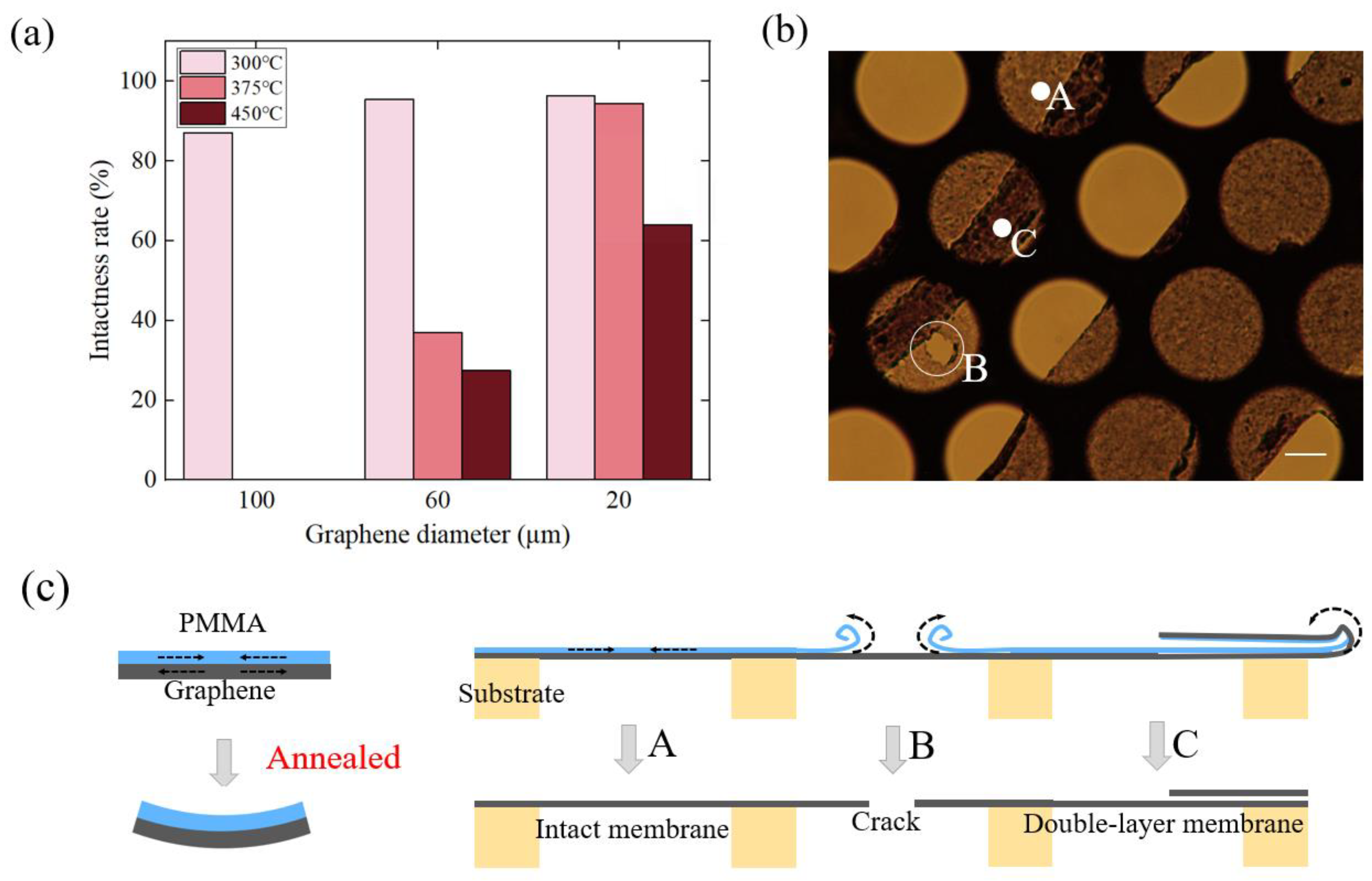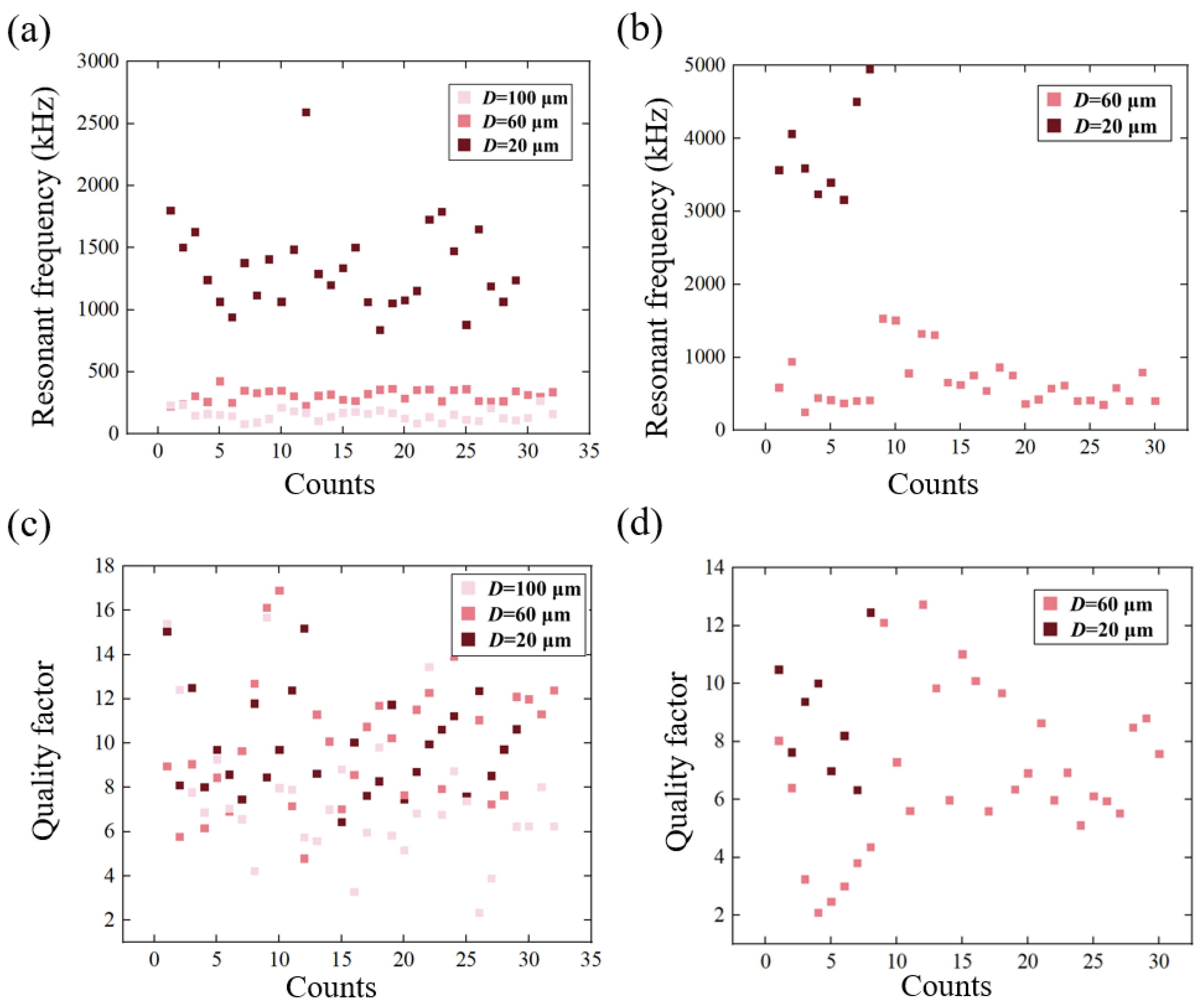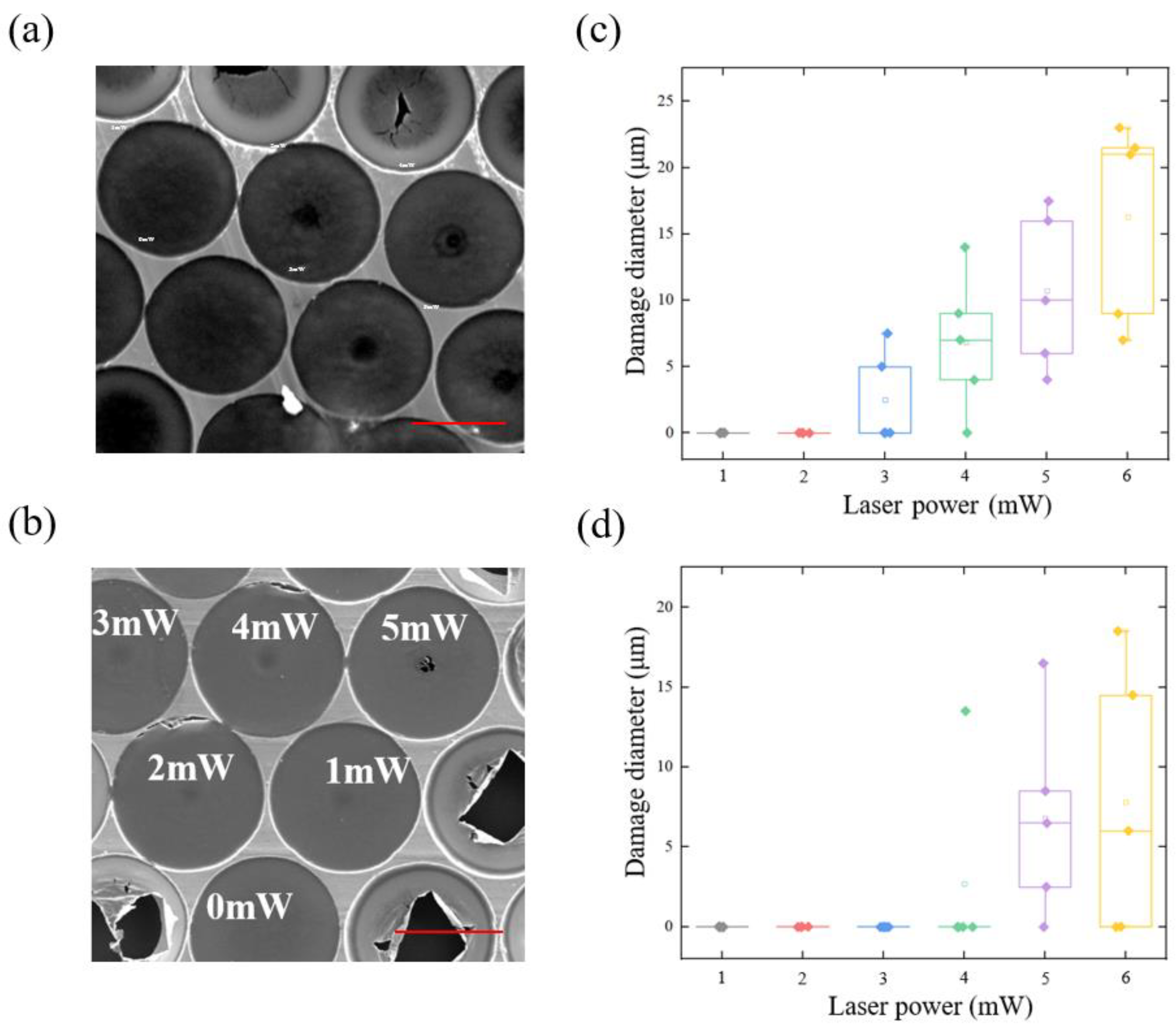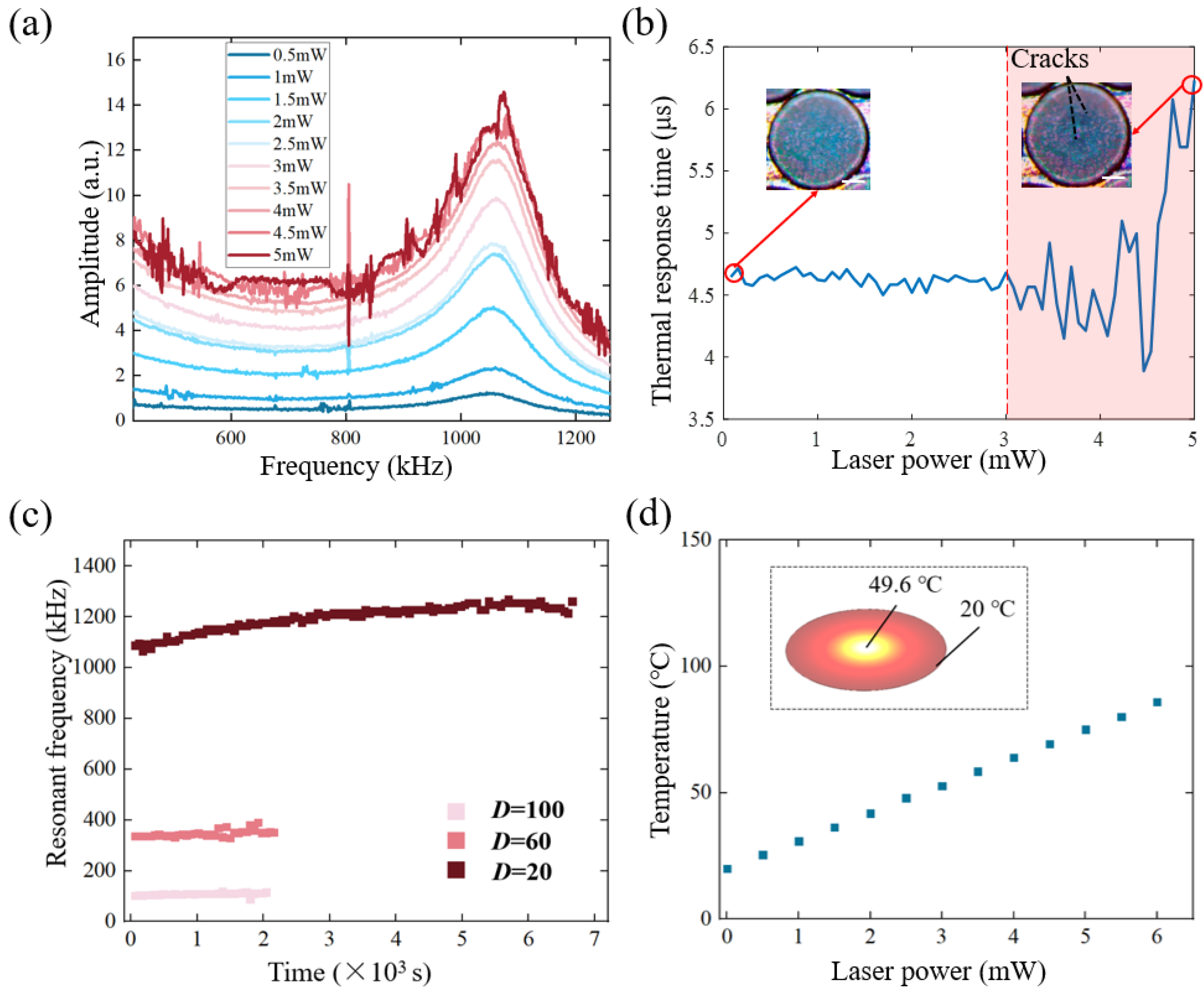The Effect of Annealing and Optical Radiation Treatment on Graphene Resonators
Abstract
:1. Introduction
2. Experiment Methods
3. Results and Discussions
3.1. Damage in the Annealing Process
3.2. Damage in the Laser Irradiation Process
4. Conclusions
Author Contributions
Funding
Data Availability Statement
Conflicts of Interest
References
- Lee, C.; Wei, X.; Kysar, J.W.; Hone, J. Measurement of the elastic properties and intrinsic strength of monolayer graphene. Science 2008, 321, 385–388. [Google Scholar] [CrossRef]
- Bonaccorso, F.; Sun, Z.; Hasan, T.A.; Ferrari, A.C. Graphene photonics and optoelectronics. Nat. Photonics 2010, 4, 611–622. [Google Scholar] [CrossRef] [Green Version]
- Pereira, V.M.; Castro, N.A.H. Strain engineering of graphene’s electronic structure. Phys. Rev. Lett. 2009, 103, 046801. [Google Scholar] [CrossRef] [PubMed] [Green Version]
- Balandin, A.A.; Ghosh, S.; Bao, W. Superior thermal conductivity of single-layer graphene. Nano Lett. 2008, 8, 902–907. [Google Scholar] [CrossRef] [PubMed]
- Xi, J.Y.; Jia, R.; Li, W.; Wang, J.; Bai, F.Q.; Eglitis, R.I.; Zhang, H.X. How does graphene enhance the photoelectric conversion efficiency of dye sensitized solar cells? An insight from a theoretical perspective. J. Mater. Chem. A 2019, 7, 2730–2740. [Google Scholar] [CrossRef]
- Jiang, J.; Wang, J.; Li, B. Young’s modulus of graphene: A molecular dynamics study. Phys. Rev. B 2009, 80, 113405. [Google Scholar] [CrossRef] [Green Version]
- Cui, T.; Mukherjee, S.; Sudeep, P.M. Fatigue of graphene. Nat. Mater. 2020, 19, 405–411. [Google Scholar] [CrossRef] [PubMed]
- Bunch, J.S.; van der Zande, A.M.; Verbridge, S.S. Electromechanical resonators from graphene sheets. Science 2007, 315, 490–493. [Google Scholar] [CrossRef] [Green Version]
- Dolleman, R.J.; Vidovikj, D.D.; Cartamil-Bueno, S.J. Graphene squeeze-film pressure sensors. Nano Lett. 2016, 16, 568–571. [Google Scholar] [CrossRef] [Green Version]
- Harada, K.; Ikeda, K.; Kuwayama, H. Various applications of resonant pressure sensor chip based on 3-D micromachining. Sens. Actuator A Phys. 1999, 73, 261–266. [Google Scholar] [CrossRef]
- Greenwood, J.C. Etched silicon vibrating sensor. J. Phys. E Sci. Instr. 1984, 17, 650–652. [Google Scholar] [CrossRef]
- Mandle, J.; Lefort, O.; Migeon, A. A new micromachined silicon high-accuracy pressure sensor. Sens. Actuator A Phys. 1995, 46, 129–132. [Google Scholar] [CrossRef]
- Věí, J. Temperature compensation of silicon resonant pressure sensor. Sens. Actuator A Phys. 1996, 57, 179–182. [Google Scholar]
- Kang, J.; Shin, D.; Bae, S. Graphene transfer: Key for applications. Nanoscale 2012, 4, 5527–5537. [Google Scholar] [CrossRef] [PubMed]
- Kim, K.; Zhao, Y.; Jang, H. Large-scale pattern growth of graphene films for stretchable transparent electrodes. Nature 2009, 457, 706–710. [Google Scholar] [CrossRef]
- Ali, U.; Karim, K.J.B.A.; Buang, N.A. A review of the properties and applications of Poly (Methyl Methacrylate) (PMMA). Polym. Rev. 2015, 55, 678–705. [Google Scholar] [CrossRef]
- Reina, A.; Jia, X.; Ho, J. Large area, few-layer graphene films on arbitrary substrates by chemical vapor deposition. Nano Lett. 2009, 9, 30–35. [Google Scholar] [CrossRef]
- Schmid, S.; Bagci, T.; Zeuthen, E. Single-layer graphene on silicon nitride micromembrane resonators. J. Appl. Phys. 2014, 115, 054513. [Google Scholar] [CrossRef] [Green Version]
- Oshidari, Y.; Hatakeyama, T.; Kometani, R. High quality factor graphene resonator fabrication using resist shrinkage-induced strain. Appl. Phys. Lett. 2012, 5, 117201. [Google Scholar] [CrossRef]
- Rouxinol, F.P.; Gelamo, R.V.; Amici, R.G. Low contact resistivity and strain in suspended multilayer graphene. Appl. Phys. Lett. 2010, 97, 253104. [Google Scholar] [CrossRef] [Green Version]
- Robinson, J.T.; Zalalutdinov, M.K.; Cress, C.D. Graphene strained by defects. ACS Nano 2017, 11, 4745–4752. [Google Scholar] [CrossRef] [PubMed]
- Cheng, Z.; Zhou, Q.; Wang, C. Toward intrinsic graphene surfaces: A systematic study on thermal annealing and wet-chemical treatment of SiO2-supported graphene devices. Nano Lett. 2011, 11, 767–771. [Google Scholar] [CrossRef] [PubMed]
- Barton, R.A.; Ilic, B.; van der Zande, A.M. High, size-dependent quality factor in an array of graphene mechanical resonators. Nano Lett. 2011, 11, 1232–1236. [Google Scholar] [CrossRef] [PubMed]
- Currie, M.; Caldwell, J.D.; Bezares, F.J. Quantifying pulsed laser induced damage to graphene. Appl. Phys. Lett. 2011, 99, 211901. [Google Scholar] [CrossRef] [Green Version]
- Yoo, J.H.; In, J.B.; Park, J.B. Graphene folds by femtosecond laser ablation. Appl. Phys. Lett. 2012, 100, 233124. [Google Scholar] [CrossRef]
- Lenner, M.; Kaplan, A.; Palmer, R.E. Nanoscopic Coulomb explosion in ultrafast graphite ablation. Appl. Phys. Lett. 2007, 90, 153119. [Google Scholar] [CrossRef]
- Qiu, B.; Ruan, X. Reduction of spectral phonon relaxation times from suspended to supported graphene. Appl. Phys. Lett. 2012, 100, 193101. [Google Scholar] [CrossRef] [Green Version]
- Lenner, M.; Kaplan, A.; Huehon, C. Ultrafast laser ablation of graphite. Phys. Rev. B 2009, 79, 184105. [Google Scholar] [CrossRef]
- Ferriol, M.; Gentilhomme, A.; Cochez, M. Thermal degradation of Poly (methyl methacrylate) (PMMA): Modelling of DTG and TG curves. Polym. Degrad. Stabil. 2003, 79, 271–281. [Google Scholar] [CrossRef]
- Ma, J.; Jin, W. Fiber-optic ferrule-top nanomechanical resonator with multilayer graphene film. Opt. Lett. 2014, 39, 4769–4772. [Google Scholar] [CrossRef]
- Süske, E.; Scharf, T.; Schaaf, P. Variation of the mechanical properties of pulsed laser deposited PMMA films during annealing. Appl. Phys. A. 2004, 79, 1295–1297. [Google Scholar] [CrossRef]
- Nanzai, Y.; Miwa, A.; Cui, S.Z. Aging in fully annealed and subsequently strained Poly (methyl methacrylate). Polym. J. 2000, 32, 51–56. [Google Scholar] [CrossRef] [Green Version]
- Xie, W.; Weng, L.; Ng, K.M. Clean graphene surface through high temperature annealing. Carbon 2015, 94, 740–748. [Google Scholar] [CrossRef]
- Bao, W.; Miao, F.; Chen, Z. Controlled ripple texturing of suspended graphene and ultrathin graphite membranes. Nat. Nanotechnol. 2009, 4, 562–566. [Google Scholar] [CrossRef] [PubMed] [Green Version]
- Roberts, A.; Cormode, D.; Reynolds, C.; Newhouse-Illige, T.; LeRoy, B.J.; Sandhu, A.S. Response of graphene to femtosecond high-intensity laser irradiation. Appl. Phys. Lett. 2011, 99, 051912. [Google Scholar] [CrossRef] [Green Version]
- Beltaos, A.; Kovačević, A.; Matković, A. Damage effects on multi-layer graphene from femtosecond laser interaction. Phys. Scr. 2014, 162, 014015. [Google Scholar] [CrossRef]
- Takeuchi, Y. Thermal Stress; Science Press: Beijing, China, 1977; pp. 77–79. [Google Scholar]
- Metzger, C.; Favero, I.; Ortlieb, A. Optical self-cooling of a deformable Fabry-Perot cavity in the classical limit. Phys. Rev. B 2008, 57, 1436–1446. [Google Scholar] [CrossRef] [Green Version]
- Dolleman, R.J.; Houri, S.; Davidovikj, D. Optomechanics for thermal characterization of suspended graphene. Phys. Rev. B 2017, 96, 165421. [Google Scholar] [CrossRef] [Green Version]
- Renteria, J.D.; Nika, D.L.; Balandin, A.A. Graphene thermal properties: Applications in thermal management and energy storage. Appl. Sci. 2014, 4, 525–547. [Google Scholar] [CrossRef] [Green Version]
- Lin, Y.; Lu, C.; Yeh, C. Graphene annealing: How clean can it be. Nano Lett. 2012, 12, 414–419. [Google Scholar] [CrossRef]






Publisher’s Note: MDPI stays neutral with regard to jurisdictional claims in published maps and institutional affiliations. |
© 2022 by the authors. Licensee MDPI, Basel, Switzerland. This article is an open access article distributed under the terms and conditions of the Creative Commons Attribution (CC BY) license (https://creativecommons.org/licenses/by/4.0/).
Share and Cite
Liu, Y.; Li, C.; Fan, S.; Song, X.; Wan, Z. The Effect of Annealing and Optical Radiation Treatment on Graphene Resonators. Nanomaterials 2022, 12, 2725. https://doi.org/10.3390/nano12152725
Liu Y, Li C, Fan S, Song X, Wan Z. The Effect of Annealing and Optical Radiation Treatment on Graphene Resonators. Nanomaterials. 2022; 12(15):2725. https://doi.org/10.3390/nano12152725
Chicago/Turabian StyleLiu, Yujian, Cheng Li, Shangchun Fan, Xuefeng Song, and Zhen Wan. 2022. "The Effect of Annealing and Optical Radiation Treatment on Graphene Resonators" Nanomaterials 12, no. 15: 2725. https://doi.org/10.3390/nano12152725
APA StyleLiu, Y., Li, C., Fan, S., Song, X., & Wan, Z. (2022). The Effect of Annealing and Optical Radiation Treatment on Graphene Resonators. Nanomaterials, 12(15), 2725. https://doi.org/10.3390/nano12152725






